Iodate - Study guides, Class notes & Summaries
Looking for the best study guides, study notes and summaries about Iodate? On this page you'll find 38 study documents about Iodate.
Page 3 out of 38 results
Sort by
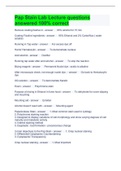
-
Pap Stain Lab Lecture questions answered 100% correct
- Exam (elaborations) • 7 pages • 2023
-
Available in package deal
-
- $19.49
- + learn more
Pap Stain Lab Lecture questions answered 100% correct Remove coating fixative in 95% alcohol for 15 min Coating Fixative ingredients 95% Ethanol and 2% CarboWax ( water soluble) Running in Tap water For excess dye off Harris' Hematoxylin To demonstrate nucleus Acid alcohol Clarifier Running tap water after acid alcohol To stop the reaction Bluing reagent Permanent Nuclei dye : acidic to alkaline After microscopic check, not enough nuclei ...

-
Test Bank For Chemistry And Chemical Reactivity International Edition 8th Edition By John C. Kotz
- Exam (elaborations) • 300 pages • 2023
-
- $36.48
- + learn more
Chapter 3—Chemical Reactions MULTIPLE CHOICE 1. Nitroglycerin decomposes violently according to the balanced chemical equation below. 2 C3H5(NO3)3( ) 3 N2(g) + 1/2 O2(g) + 6 CO2(g) + 5 H2O(g) Which of the following statements concerning this reaction is/are CORRECT? 1. Two moles of nitroglycerine will produce three moles of nitrogen and five moles of water. 2. Four molecules of nitroglycerine will produced one molecule of oxygen and twelve molecules of carbon dioxide. 3. Six grams...
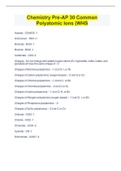
-
Chemistry Pre-AP 30 Common Polyatomic Ions (WHS
- Exam (elaborations) • 3 pages • 2023
-
- $11.49
- + learn more
Acetate - C2H3O2 -1 Ammonium - NH4 +1 Bromate - BrO3 -1 Bromite - BrO2 -1 Carbonate - CO3 -2 Charges - Do not change with added oxygen atoms (Ex: hypoiodite, iodite, iodate, and periodate all have the same charge of -1) Charges of Bromine polyatomics - -1 (not Cl, I, or N) Charges of Carbon polyatomics (oxygen-based) - -2 (not S or Cr) Charges of Chlorine polyatomics - -1 (not N, I, or Br) Charges of Chromite polyatomics - -2 (not C or S) Charges of Iodine polyatomics - -1 (not Cl, N...
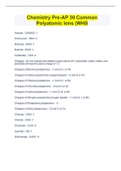
-
Chemistry Pre-AP 30 Common Polyatomic Ions (WHS
- Exam (elaborations) • 3 pages • 2023
-
- $11.49
- + learn more
Acetate - C2H3O2 -1 Ammonium - NH4 +1 Bromate - BrO3 -1 Bromite - BrO2 -1 Carbonate - CO3 -2 Charges - Do not change with added oxygen atoms (Ex: hypoiodite, iodite, iodate, and periodate all have the same charge of -1) Charges of Bromine polyatomics - -1 (not Cl, I, or N) Charges of Carbon polyatomics (oxygen-based) - -2 (not S or Cr) Charges of Chlorine polyatomics - -1 (not N, I, or Br) Charges of Chromite polyatomics - -2 (not C or S) Charges of Iodine polyatomics - -1 (not Cl, N...
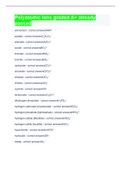
-
Polyatomic Ions graded A+ already passed
- Exam (elaborations) • 2 pages • 2022
- Available in package deal
-
- $8.49
- + learn more
Polyatomic Ions graded A+ already passedA polyatomic ion is a charged particle which has two or more atoms held together by covalent (sharing of pairs of electrons) bonds Some rules: 1. Ions that end in ate have oxygen in them. 2. Elements in the same family make similar ions. So for example if you know chlorate, you also know bromate and iodate too (BrO3-, and IO3-). There are some exceptions. Nitrate is not like phosphate even though nitrogen and phosphorus are in the same group. However ar...
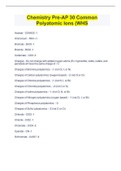
-
Chemistry Pre-AP 30 Common Polyatomic Ions (WHS
- Exam (elaborations) • 3 pages • 2023
-
- $10.49
- + learn more
Acetate - C2H3O2 -1 Ammonium - NH4 +1 Bromate - BrO3 -1 Bromite - BrO2 -1 Carbonate - CO3 -2 Charges - Do not change with added oxygen atoms (Ex: hypoiodite, iodite, iodate, and periodate all have the same charge of -1) Charges of Bromine polyatomics - -1 (not Cl, I, or N) Charges of Carbon polyatomics (oxygen-based) - -2 (not S or Cr) Charges of Chlorine polyatomics - -1 (not N, I, or Br) Charges of Chromite polyatomics - -2 (not C or S) Charges of Iodine polyatomics - -1 (not Cl, N...
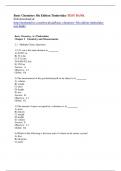
-
Introduction to Chemistry 5th Edition Bauer Test Bank
- Exam (elaborations) • 23 pages • 2024
-
- $14.99
- + learn more
Introduction to Chemistry 5th Edition by Rich Bauer – Test Bank Description Introduction to Chemistry 5th Edition by Rich Bauer – Test Bank Sample Questions Instant Download With Answer s Introduction to Chemistry, 5e (Bauer) Chapter 3 Chemical Compounds 1) The figure shows all but which of the following? 1. A) two elements and a compound 2. B) a chemical reaction 3. C) one mixture and one pure substance 4. D) three compounds Answer: D Difficulty: 1 Easy Topic: Study of Chemistry Bloom’s: ...
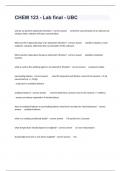
-
CHEM 123 - Lab final - UBC Exam With 100% Verified Answers A+ Guaranteed.
- Exam (elaborations) • 14 pages • 2024
-
Available in package deal
-
- $12.99
- + learn more
why do we perform iodometric titrations - correct answer to find the concentration of an unknown by mixing it with a solution of known concentration What are the 4 (general) steps of an iodometric titration? - correct answer combine solutions, reach endpoint, calculate, determine the concentration of the unknown What reaction takes place during an iodometric titration? - correct answer oxidation-reduction reaction what is used as the oxidizing agent in an iodometric titra...
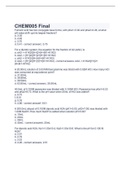
-
CHEM005 Final 2023 with verified questions and answers
- Exam (elaborations) • 6 pages • 2023
-
Available in package deal
-
- $8.99
- + learn more
Fumaric acid has two conjugate base forms, with pKa1=3.02 and pKa2=4.48, at what pH value αHA- got its largest fractions? a. 3.02 b. 4.48 c. 3.75 d. 5.41 c. 3.75 For a diprotic system, the equation for the fraction of A2-(αA2-) is a. αA2- = K1K2/([H+]2+[H+]K1+K1K2) b. αA2- = [H+]2/([H+]2+[H+]K1+K1K2) c. αA2- = K1K2/([H+]+[H+]K1+K1K2) d. αA2- = [H+]2/([H+]+[H+]K1+K1K2) a. αA2- = K1K2/([H+]2+[H+]K1+K1K2) A 25.00mL solution of 0.0316M benzylamine was titratd with 0.02...
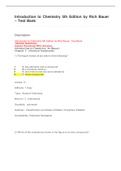
-
Introduction to Chemistry 5th Edition by Rich Bauer - Test Bank.
- Exam (elaborations) • 50 pages • 2021
-
- $12.99
- 8x sold
- + learn more
Introduction to Chemistry 5th Edition by Rich Bauer – Test Bank Description Introduction to Chemistry 5th Edition by Rich Bauer – Test Bank Sample Questions Instant Download With Answer s Introduction to Chemistry, 5e (Bauer) Chapter 3 Chemical Compounds 1) The figure shows all but which of the following? 1. A) two elements and a compound 2. B) a chemical reaction 3. C) one mixture and one pure substance 4. D) three compounds Answer: D Difficulty: 1 Easy Topic: Study of Chemistry Bloom’s: ...

$6.50 for your textbook summary multiplied by 100 fellow students... Do the math: that's a lot of money! Don't be a thief of your own wallet and start uploading yours now. Discover all about earning on Stuvia


